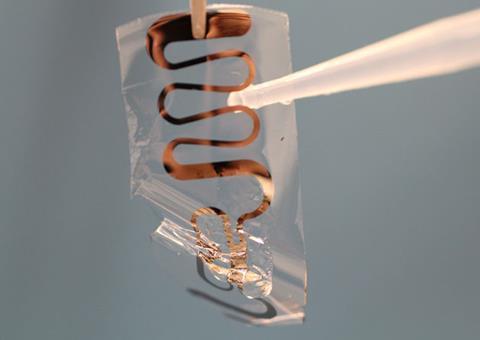A radio tracking tag made completely of soluble components for eco-friendly disposal

A water soluble radio-frequency identification (RFID) tag that can melt away in a matter of minutes has been developed in John Rogers’ lab at the University of Illinois at Urbana-Champaign in the US. Rogers presented the work at the 247th ACS National Meeting & Exposition in Dallas, US.
RFID tags are widely used for tracking consumer products, livestock and people – billions are produced each year. Most end up in landfill after a short period of time, but Rogers’ team have developed a prototype that could be easily recycled or reabsorbed into the environment once discarded. The work is part of a broader project to develop ‘transient’ electronics. In the past, the group have made dissolvable medical implants that don’t require surgery to retrieve, and they are currently working on a biodegradable battery.
The prototype RFID contains extremely thin – around 20nm thick – layers of silicon and zinc that make up the antenna and circuitry. These are transfer printed onto a soluble cellulose sheet. The whole device starts to crumple and melt away immediately when sprayed or immersed in water, and within a few minutes it completely disappears.
Rogers is optimistic the technology could be adopted by manufacturers, as it uses materials already used to make electronics. The next step, he says, is to develop a way to control the dissolving, so that the tag melts away after a desired period of time, or in response to a trigger.







No comments yet